Register now or log in to join your professional community.

Classification of pile with respect to load transmission and functional behavior
End bearing piles
These piles transfer their load on to a firm stratum located at a considerable depth below the base of the structure and they derive most of their carrying capacity from the penetration resistance of the soil at the toe of the pile (see figure 1). The pile behaves as an ordinary column and should be designed as such. Even in weak soil a pile will not fail by buckling and this effect need only be considered if part of the pile is unsupported, i.e. if it is in either air or water. Load is transmitted to the soil through friction or cohesion. But sometimes, the soil surrounding the pile may adhere to the surface of the pile and causes "Negative Skin Friction" on the pile. This, sometimes have considerable effect on the capacity of the pile. Negative skin friction is caused by the drainage of the ground water and consolidation of the soil. The founding depth of the pile is influenced by the results of the site investigate on and soil test.
Friction or cohesion piles
Carrying capacity is derived mainly from the adhesion or friction of the soil in contact with the shaft of the pile (see fig 2).

Figure 1:End bearing piles
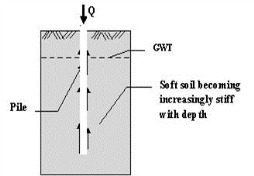
Figure 2:Friction or cohesion pile
Cohesion piles
These piles transmit most of their load to the soil through skin friction. This process of driving such piles close to each other in groups greatly reduces the porosity and compressibility of the soil within and around the groups. Therefore piles of this category are sometimes called compaction piles. During the process of driving the pile into the ground, the soil becomes molded and, as a result loses some of its strength. Therefore the pile is not able to transfer the exact amount of load which it is intended to immediately after it has been driven. Usually, the soil regains some of its strength three to five months after it has been driven.
Friction piles
These piles also transfer their load to the ground through skin friction. The process of driving such piles does not compact the soil appreciably. These types of pile foundations are commonly known as floating pile foundations.
Combination of friction piles and cohesion piles
An extension of the end bearing pile when the bearing stratum is not hard, such as firm clay. The pile is driven far enough into the lower material to develop adequate frictional resistance. A farther variation of the end bearing pile is piles with enlarged bearing areas. This is achieved by forcing a bulb of concrete into the soft stratum immediately above the firm layer to give an enlarged base. A similar effect is produced with bored piles by forming a large cone or bell at the bottom with a special reaming tool. Bored piles which are provided with a bell have a high tensile strength and can be used as tension piles (see fig.3)
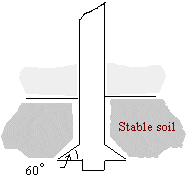
Figure 3:under-reamed base enlargement to a bore-and-cast-in-situ pile
Classification of pile with respect to type of material
Piles are usually made of timber, concrete or steel. Timber can be used for the manufacture of temporary piles and when the wood is available at an economical price. Concrete is used for the manufacture of pre-cast concrete piles, cast in place and pre-stressed concrete piles, while steel piles are used for permanent or temporary works.
Used from earliest record time and still used for permanent works in regions where timber is plentiful. Timber is most suitable for long cohesion piling and piling beneath embankments. The timber should be in a good condition and should not have been attacked by insects.
For timber piles of length less than 14 meters, the diameter of the tip should be greater than 150 mm. If the length is greater than 18 meters a tip with a diameter of 125 mm is acceptable. It is essential that the timber is driven in the right direction and should not be driven into firm ground. As this can easily damage the pile. Keeping the timber below the ground water level will protect the timber against decay and putrefaction. To protect and strengthen the tip of the pile, timber piles can be provided with toe cover. Pressure creosoting is the usual method of protecting timber piles.
Advantages and disadvantages of Wood piles
+ The piles are easy to handle
+ Relatively inexpensive where timber is plentiful.
+ Sections can be joined together and excess length easily removed.
— The piles will rot above the ground water level. Have a limited bearing capacity.
— Can easily be damaged during driving by stones and boulders.
— The piles are difficult to splice and are attacked by marine borers in salt water.
Concrete piles can be divided to pre-cast and cast in place concrete piles:
Pre- cast concrete Piles or Pre fabricated concrete piles
it is formed and reinforced in a high-quality controlled concrete, Usually used of square (see fig 1-4 b), triangle, circle or octagonal section, they are produced in short length in one meter intervals between 3 and 13 meters. They are pre-caste so that they can be easily connected together in order to reach to the required length (fig 1-4 a). This will not decrease the design load capacity. Reinforcement is necessary within the pile to help withstand both handling and driving stresses. Pre stressed concrete piles are also used and are becoming more popular than the ordinary pre cast as less reinforcement is required.
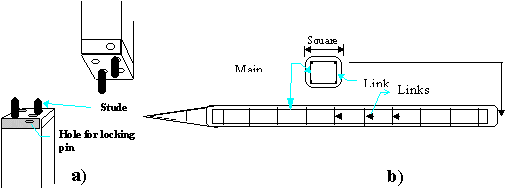
Figure 4:a) concrete pile connecting detail. b) squared pre-cast concert pile
The Hercules type of pile joint (Figure 5) is easily and accurately cast into the pile and is quickly and safely joined on site. They are made to accurate dimensional tolerances from high grade steels.

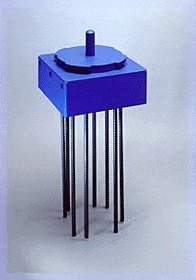

Figure 5:Hercules type of pile joint
Advantages and disadvantages of Pre- cast concrete Piles
+ Are easy to splice. Relatively inexpensive.
+ Stable in squeezing ground, for example, soft clays, silts and peats pile material can be inspected before piling.
+ Can be driven in long lengths.
+ Can increase the relative density of a granular founding stratum.
— Displacement, heave, and disturbance of the soil during driving.
— Can be damaged during driving. Replacement piles may be required.
— Cannot be driven with very large diameters or in condition of limited headroom.
Cast in place Concrete piles
Cast in place concrete piles are the most type commonly used for foundations due to the great diversity available for pouring concrete and the introduction of the pile into the soil. Driving and drilling piles are two types of cast in place concrete piles; however, the implementation of these piles in place may be accompanied by some problems such as arching, squeezing and segregation.
These piles are divided to:
Piles are poured in tubes with underneath heels and left when lifting the tubes. some of those types:
Advantages and disadvantages of cast-in-place concrete piles
+ Can be inspected before casting can easily be cut or extended to the desired length.
+ Relatively inexpensive.
+ The piles can be cast before excavation.
+ Pile lengths are readily adjustable.
+ An enlarged base can be formed which can increase the relative density of a granular founding stratum leading to much higher end bearing capacity.
+ Reinforcement is not determined by the effects of handling or driving stresses.
— Heave of neighboring ground surface, which could lead to re consolidation and the development of negative skin friction forces on piles..
— Tensile damage to unreinforced piles or piles consisting of green concrete, where forces at the toe have been sufficient to resist upward movements.
— Damage piles consisting of uncased or thinly cased green concrete due to the lateral forces set up in the soil. Concrete may be weakened if artesian flow pipes up shaft of piles when tube is withdrawn.
— Light steel section or Pre-cast concrete shells may be damaged or distorted by hard driving.
— Cannot be driven where headroom is limited.
— Time consuming; cannot be used immediately after the installation.
— Limited length.
Bored and cast in -place (non -displacement piles)
+ Length can be readily varied to suit varying ground conditions.
+ Can be installed in very large diameters.
+ End enlargement up to two or three diameters are possible in clays.
+ Material of piles is not dependent on handling or driving conditions.
+ Can be installed in very long lengths.
— Concrete is not placed under ideal conditions and cannot be subsequently inspected.
— Water under artesian pressure may pipe up pile shaft washing out cement.
— Cannot be readily extended above ground level especially in river and marine structures.
— Boring methods may loosen sandy or gravely soils requiring base grouting to achieve economical base resistance.
Steel piles
Made of sectors in the form of H, X or of thick pipes (see fig. 6). They are suitable for handling and driving in long lengths. Their relatively small cross-sectional area combined with their high strength makes penetration easier in firm soil. They can be easily cut off or joined by welding. If the pile is driven into a soil with low pH value, then there is a risk of corrosion, but risk of corrosion is not as great as one might think. Although tar coating or cathodic protection can be employed in permanent works.
It is common to allow for an amount of corrosion in design by simply over dimensioning the cross-sectional area of the steel pile. In this way the corrosion process can be prolonged up to 50 years. Normally the speed of corrosion is 0.2-0.5 mm/year and, in design, this value can be taken as 1mm/year



a) X- cross-section
b) H – cross-section
c) steel pipe
Figure 6 Steel piles cross-sections
Advantages and disadvantages of Steel piles
+ The piles are easy to handle and can easily be cut to desire length.
+ Can be driven through dense layers. The lateral displacement of the soil during driving is low (steel section H or I section piles) can be relatively easily spliced or bolted.
+ Can be driven hard and in very long lengths.
+ Can carry heavy loads.
— The piles will corrode,
— Will deviate relatively easy during driving.
— Are relatively expensive.
Composite piles
Combination of different materials in the same of pile. As indicated earlier, part of a timber pile which is installed above ground water could be vulnerable to insect attack and decay. To avoid this, concrete or steel pile is used above the ground water level, whilst wood pile is installed under the ground water level (see figure 7).
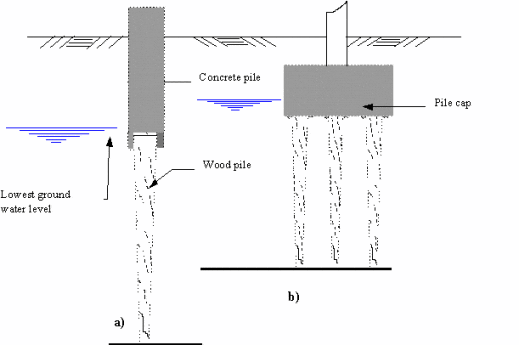
Figure 7: Protecting timber piles from decay: a) by pre-cast concrete upper section above water level. b) by extending pile cap below water level
Classification of pile with respect to effect on the soil
A simplified division into driven or bored piles is often employed.
Driven piles are considered to be displacement piles. In the process of driving the pile into the ground, soil is moved radially as the pile shaft enters the ground. There may also be a component of movement of the soil in the vertical direction.

Figure 8: driven piles
Bored piles (Replacement piles) are generally considered to be non-displacement piles a void is formed by boring or excavation before piles is produced. Piles can be produced by casting concrete in the void. Some soils such as stiff clays are particularly amenable to the formation of piles in this way, since the bore hole walls do not requires temporary support except cloth to the ground surface. In unstable ground, such as gravel the ground requires temporary support from casing or bentonite slurry. Alternatively the casing may be permanent, but driven into a hole which is bored as casing is advanced. A different technique, which is still essentially non-displacement, is to intrude, a grout or a concrete from an auger which is rotated into the granular soil, and hence produced a grouted column of soil.
There are three non-displacement methods: bored cast- in – place piles, particularly pre-formed piles and grout or concrete intruded piles.
The following are replacement piles:

Thanks for the invitation. Sorry, I do not know the answer.

Agreed with experts detain answer -----------------

There are two types of pile foundations, each of which works in its own way. End Bearing Piles. In end bearing piles, the bottom end of the pile rests on a layer of especially strong soil or rock. The load of the building is transferred through the pile onto the strong layer. In a sense, this pile acts like a column.

Thank you for the invitation. Sorry, I have no knowledge about it.

thank you for invitation i am bit late

Thank you for the invitation
Thanks to Mr. Hisham for the detailed and useful answer and a good greeting to all



